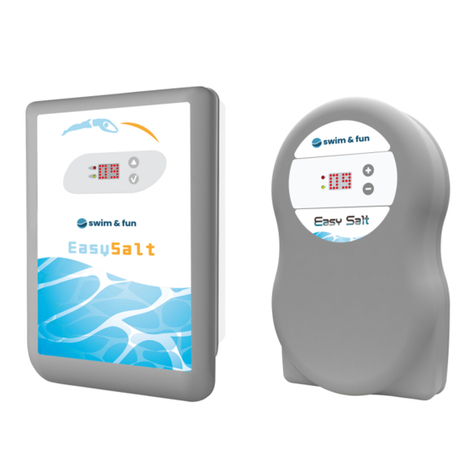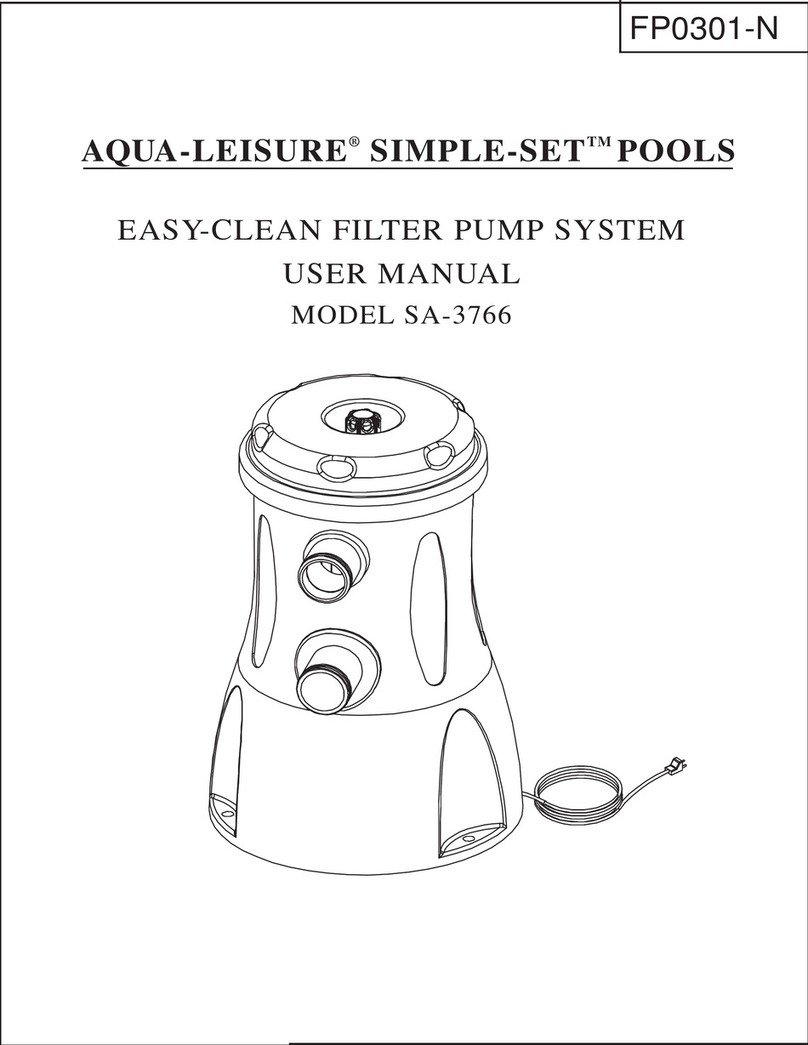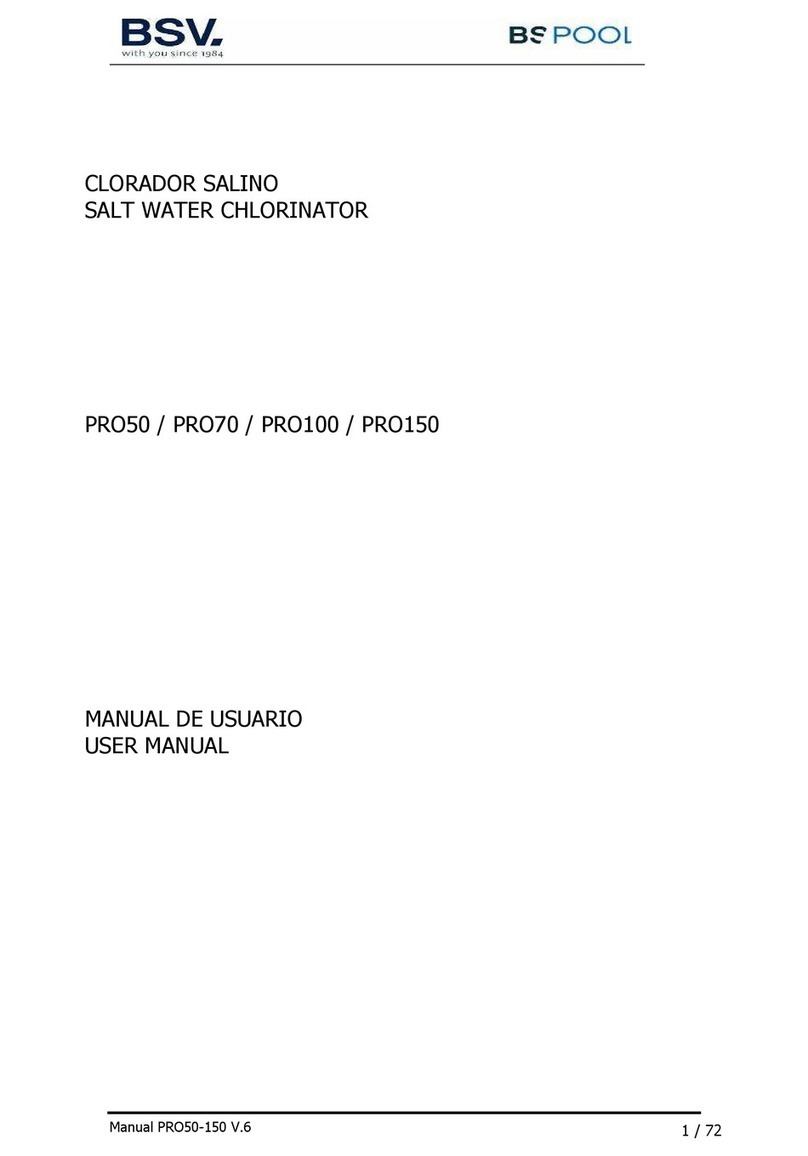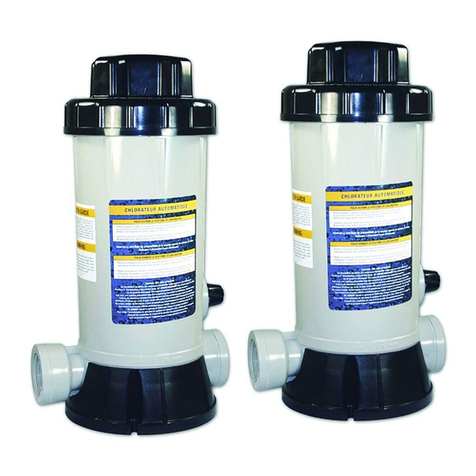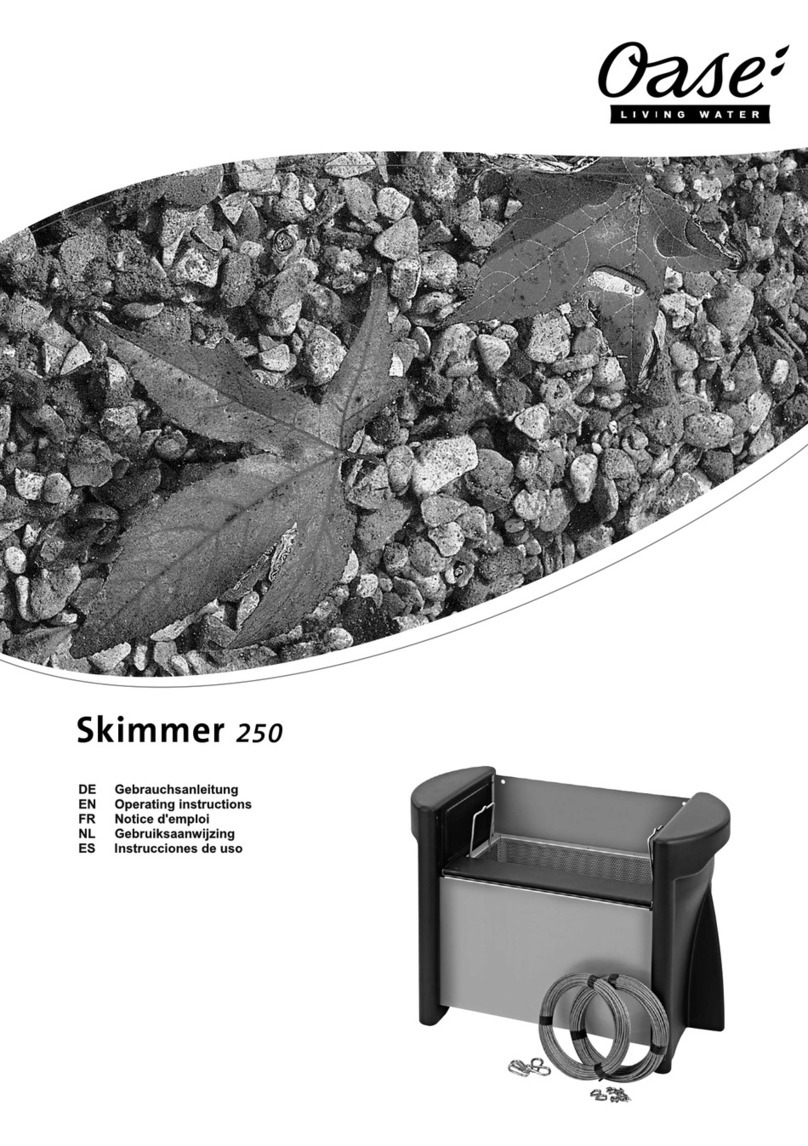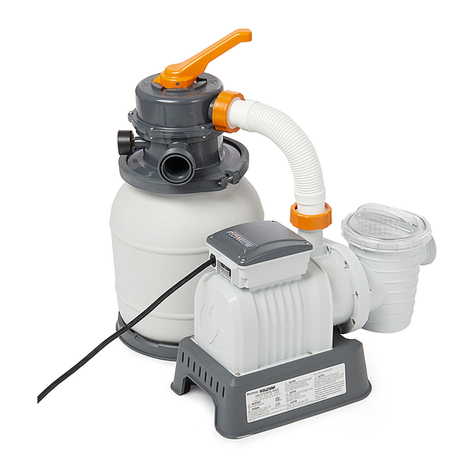Davis & Shirtliff DAYLIFF DX Series Installation instructions

DX Filter
Installation &
Operating Manual

INDEX
© Davis & Shirtliff Ltd 2022
Contents herein are not warranted
SPECIFICATIONS
1.
1
2.
INSTALLATION 3
3.
OPERATION 6
4.
TROUBLE SHOOTING 8
5.
TERMS OF WARRANTY 9

1
1. FILTER SPECIFICATIONS
The DAYLIFF 'DX' filter range is a comprehensive selection of swimming pool
filters suitable for both domestic and light institutional pool applications.
Combining the latest filtration technology with nearly twenty years of production
experience the range offers outstanding reliability, longevity, performance and
value. Five models in different sizes are available, all providing the following
features:-
l Elegant moulded filter bodies of non-corroding GRP construction for
strength and longetivity.
l Simple to use flange connected six-position multiport valves with union
connections. The flange arrangement greatly simplifies installation and
media replacement as well as providing a secure watertight seal.
l Specially designed internal collector laterals providing maximum
filtration and backwashing efficiency and minimal media loss.
l High-grade silica sand and glass media for exceptional filtration
performance.
Congratulations on selecting a Dayliff DX Filters. They are
manufactured to the highest standards and if installed and operated
correctly will give many years of efcient and trouble free service.
Careful reading of this Installation Manual is therefore important,
though should there be any queries they should be referred to the
equipment supplier.

2
It must be remembered that the most important aspect of a pool's appearance is
the quality of its water. The key to this is efficient filtration and a pool's filter is the
one piece of equipment where compromise does not pay. DAYLIFF 'DX' filters
are quality products which have been carefully designed to combine the highest
standards of performance with outstanding reliability and ease of operation.
With a DAYLIFF filter clean, sparkling water is assured at all times.
OPERATING PARAMETERS
H
From pool
To pool
Multiport valve
To waste
D
* Includes media and water
Dayliff DAB Power,
kW
SPP50M
SPP50M
DPL550
4
0.07
DPL550
SPP75MDPL750
SPP150MDPX1100
SPP200MDPX1100
SPP300MDPX1500
0.55
0.75
1.5
0.5
2.2
1.5
0.33
0.33 40,000
0.55
Light
Use
Normal
Use
Heavy
Use Suction Delivery
Recommended
Piping Size
Pool Capacity (Litres)Pump Options
Rated
Flow
3
(m /hr)
Model
DX300
DX300
Model Dimensions (mm)
H
Filter
Area
2
(m )
10
0.20
14
0.3
22
0.43
25
0.43
32
0.67
1.1
1.1
Power,
kW
1.1
100,000
140,000
220,000
250,000
300,000
30,000
80,000
115,000
180,000
200,000
240,000
25,000
60,000
85,000
130,000
150,000
180,000
1.5”
1.5”
2”
2.5”
2.5”
3”
1.5”
1.5”
1.5”
2”
2”
2.5”
DX500
DX500
DX600
DX600
DX750
DX750
DX800
DX800
DX900
DX900
830
830
980
1060
1280
1400
D
300
520
620
770
770
925
MPV
Valve Size Test
4.5
4.5
4.5
4.5
4.5
4.5
Working
3
3
3
3
3
3
Pressure (Bar) Weight (kgs)
Nett
11
13
15
21
25
32
Working*
115
170
250
420
525
820

3
2. INSTALLATION
2.1 Pipe Connections
The recommended piping layouts for “freeboard” and “decklevel” pools are
shown below. Piping should be uPVC Class C or D. Alternatively G.I. Piping
can be used if there is a risk of fracture.
Pipelines should be laid with as few bends as possible and either level or at
an even rising slope to the pump as changes in slope can lead to air pockets
and consequent operational problems. The backwash pipe must fall evenly
to a suitable discharge point below the level of the filter.
It is recommended that isolating valves be installed on the pool suction
adjacent to the pool wall and on the main drain, skimmer and vacuum
connections at the pump suction. A valve should also be fitted on the pool
return pipe if the inlets are below water level. The filter is supplied complete
with union connections to facilitate equipment removal if ever necessary.
Connections to the Multiport Valve are indicated on the appropriate outlets.
DECK LEVEL LAYOUT

4
FREE BOARD LAYOUT
2.2 Filter Positioning
When the Multiport Valve is clamped, the handle of the valve in the ‘FILTER’
position should line up with the manufacturer’s name plate. The filter should
therefore be positioned to take account of this BEFORE it is charged with
media.
2.3 Media Charging
The filter is provided with suitably graded media which should be gently
poured into the filter as per the details given below.

5
LAYER 1
LAYER 2
MODEL
LAYER 1 LAYER 2 LAYER 3
GRADE DEPTH
(MM)
DEPTH
(MM)
DEPTH
(MM)
GRADE GRADE
BAGS
(No.)
BAGS
(NO.)
BAGS
(NO.)
DX 500 C 175 0.6 A 200 1.5 NONE - -
DX 600 C 200 1.0 A 200 2.3 NONE - -
DX 750 C 200 2.0 A 200 4.5 NONE - -
DX 800 C 175 2.0 A 200 4.0 B 160 2.0
DX 900 C 200 4.0 A 200 6.0 B 110 2.0
MEDIA CHART
Sand Media
3 3
*Each standard DAYLIFF media bag is 1ft (0.03m ) & weighs appox. 50 kgs
C
DX300 - 0.3 A - 0.6 NONE - -
30% Freeboard for expansion
during backwash
When charging proceed as follows:-
! Disconnect the inlet, outlet and backwash pipes from the Multiport Valve at
the union connectors.
! Unscrew and remove the Multiport Valve clamp and lift out the valve, which
is sleeved on to an extension from the bottom collector pipes. This pipe
should now be blocked with paper or a cloth to prevent the ingress of media
during charging.
! Charge with media as per the instructions given above.
! Replace the Multiport Valve ensuring that both the valve neck and collector
O-rings have first been smeared with petroleum jelly. Note this should be
done whenever the Multiport Valve is removed.
! It is also important to ensure beforehand that all sand has been removed
from the filter O-ring seat and the O-ring itself to prevent leakage.
Rotate the Multiport Valve to align the outlet ports with the piping and ensure
proper seating. When properly seated the clamp should be secured ensuring
uniform torque but not over tightening of the clamp bolts. If the joint weeps under
pressure, reseat the MPV in a different position ensuring it is properly seated on
the filter neck. Over tightening will damage the filter.

6
2.4 Commissioning
When commissioning, the following procedure must be followed ensuring
the the MPV is properly :-
! Open all suction valves and ensure that the pump strainer is filled with
water.
! Open any valve on the return side of the filter.
! Set Multiport Valve to 'BACKWASH' and start pump.
! Check flow at the backwash pipe and allow the pump to run until the
backwash water is observed as reasonably clean, a minimum of five
minutes being recommended. This step is essential as the filter media is
not fully pre-washed and this procedure rinses the new sand clean.
Note that as the filter is initially empty it will take time to fill and there will
be a delay of a minute or two from when the pump is switched on to
when flow is observed.
! Stop pump and turn MPV to 'RINSE'.
! Start pump and allow media bed to rinse until waste water is observed
as clean. Stop pump and turn MPV to 'FILTER'.
! Start pump and allow system to operate until a steady flow is noticed at
the pool inlets. As the system is not primed it will take time for all air to
be expelled, so be prepared for a delay of up to ten minutes before a
steady flow is apparent.
Under no circumstances should the position of the
Multiport Valve be changed when the pump is running.
Always switch off the pump first or serious equipment
damage may result.
WARNING
3. OPERATION
3.1 Use of Multiport Valve
DAYLIFF filters are fitted with a Multiport Valve to control filter operation.
There are six positions on the valve and the various operations possible with
the different settings are described below.

7
FILTER
RINSE
BACKWASH During normal operation the filter will accumulate dirt in
the media bed. This is cleaned by a process of
backwashing when the filter flow is reversed and water is
pumped from the bottom to the top of the filter and then
to waste. It should be carried out whenever the filter
pressure exceeds the clean running pressure by 0.3Bar,
there is a noticeable reduction in inlet flow or weekly,
whichever is sooner. The backwashing process normally
takes 2-3 minutes and should be continued until the
waste water in the sight glass is observed as clear.
The normal operating position. Water from the pump is
fed into the top of the filter and after passing through the
media is collected at the bottom. It is then returned to the
pool through the inlet pipes.
After backwashing the filter media needs to be rinsed.
Water is pumped into the top and out of the bottom of
the filter as for normal filtering, but is then discharged to
waste. This removes any residual dirt in the media
instead of returning it to the pool. Rinsing should not
take more than one minute and again the sight glass on
the side of the valve can be used to see when the water is
clear.
WASTE
FILTER
PUMP
TO POOL
FROM POOL
WASTE
FILTER
TO POOL
FROM POOL
PUMP
PUMP
WASTE
FILTER
TO POOL
FROM POOL
3. OPERATION
TO POOL
FROM POOL
WASTE
FILTER
PUMP
RECIRCULATE
WASTE
In this position the filter is by-passed and the water is
pumped straight back into the pool. It will normally only
be necessary to use this position if there is a problem
with the filter itself (e.g. a leak or major blockage). It can
also be used if the filter is on a spa bath to increase the
pressure at the hydro-jet inlets.
The waste position is used for emptying the pool. The
filter is by-passed and water is taken straight from the
pool to waste. If it becomes necessary to empty the pool
make sure that the pump is not switched off once the
operation begins as there may be problems with priming
when the water level is below the pump. This position
can also be used for vacuuming to waste. This may be
necessary if there is a large amount of sediment on the
floor of the pool which would rapidly clog the filter in
TO POOL
FROM POOL
WASTE
FILTER
PUMP

8
WARNING
3. OPERATION
This shuts off all flow to the filter. In pool applications it is
most frequently used to isolate the filter when removing
the line strainer lid to clean the basket.
CLOSED
WASTE
FILTER
PUMP
FROM POOL
TO POOL
3.2 Maintenance of Filters
DAYLIFF filters need no routine maintenance other than regular
backwashing. However, over time the media will progressively clog and
become less effective. The period will depend upon the pool installation and
usage, though is normally some years. Ineffective media becomes apparent
through reduced filter efficiency and when this occurs re-charging with new
media will be necessary.
Important Note:-
The pipe connections must be correctly done as shown above. Hand tightening is
adequate for the MPV unions and under no circumstances should a pipe wrench
be used. If the union weeps, add more thread tape on the union threads and
make sure to check that the union O-Ring is in place.
PROBLEM
FILTER
POSSIBLE CAUSE SOLUTION
Flow rate very high
Water coming
out not clear
4. TROUBLE SHOOTING
Regulate flow rate to optimal levels
to ensure adequate filtration time
Filter not working well Check that the filter is in good
condition
Clogged sand filter Back wash the filter
Feed pump not working well
Low clean water
flow
Check that the pump performance
has not dropped drastically
Filter clogged Back wash the filter
System’s pipeline clogged Check that the pipeline is not
clogged and clean pipe if it's the case
Feed pump failed Repair or replace the pump
No water supply
at all
Check the right valves have been
closed or opened for the right
process operation
Filter clogged Backwash the filter
Valve arrangement control
Feed pump failed Repair or replace the pump

5. TERMS OF WARRANTY
i) General Liability
ii) Standard Warranty
• In lieu of any warranty, condition or liability implied by law, the liability of
Dayliff (hereafter called the Distributor) in respect of any defect or failure
of equipment supplied is limited to making good by replacement or
repair (at the Distributor’s discretion) defects which under proper use
appear therein and arise solely from faulty design, materials or
workmanship within a specified period. This period commences
immediately after the equipment has been delivered to the
customer and at its termination all liability ceases. Also the warranty
period will be assessed on the basis of the date that the Distributor is
informed of the failure.
ŸThis warranty applies solely to equipment supplied and no claim for
consequential damages, however arising, will be entertained. Also the
warranty specifically excludes defects caused by fair wear and tear, the
effects of careless handling, lack of maintenance, faulty installation,
incompetence on the part of the equipment user, Acts of God or any other
cause beyond the Distributors's reasonable control. Also, any repair or
attempt at repair carried out by any other party invalidates all
warranties.
General Terms
If equipment failure occurs in the normal course of service having been
competently installed and when operating within its specified duty limits
warranty will be provided as follows:-
• Up to three years - The item will be replaced or repaired at no
charge.
• Over three years, less than ve years - The item will be replaced or
repaired at a cost to the customer of 50% of the Davis & Shirtliff
market price.
The warranty on equipment supplied or installed by others is conditional
upon the defective unit being promptly returned free to a Davis &
Shirtliff ofce and collected thereafter when repaired. No element of site
repair is included in the warranty and any site attendance costs will be
payable in full at standard chargeout rates.
9

INS503A-12/22
This manual suits for next models
6
Table of contents
Popular Swimming Pool Filter manuals by other brands
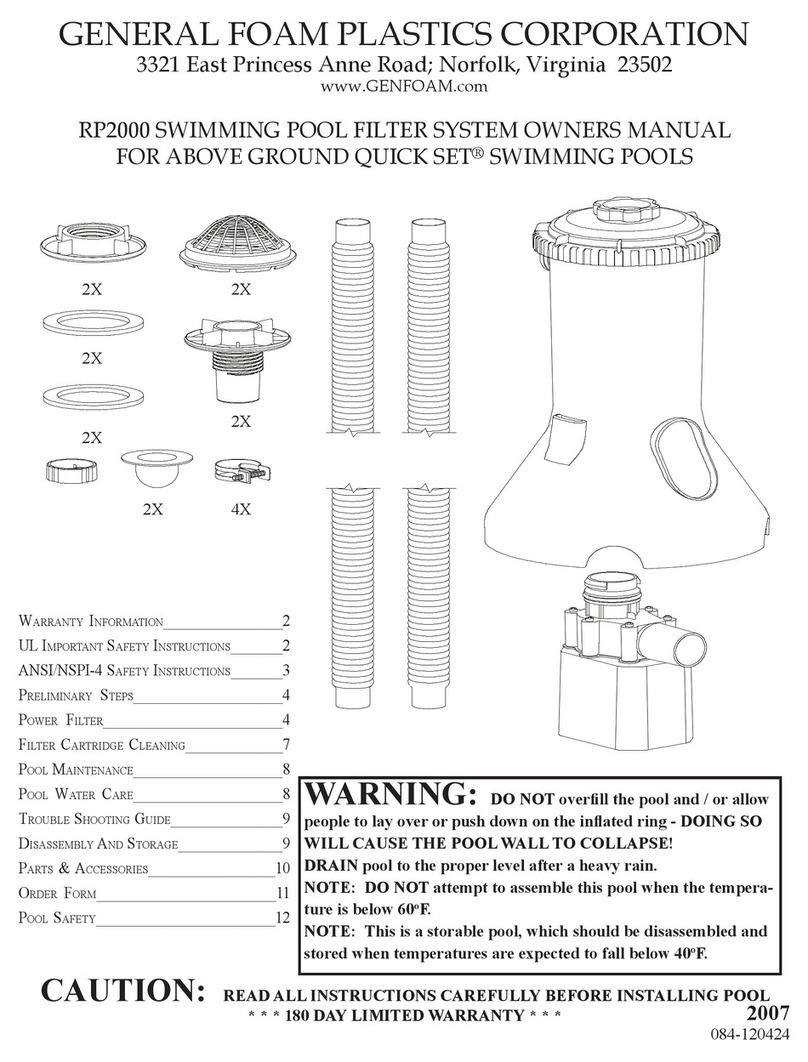
General Foam Plastics
General Foam Plastics RP2000 owner's manual

ubbink
ubbink Pool Filter 300 manual
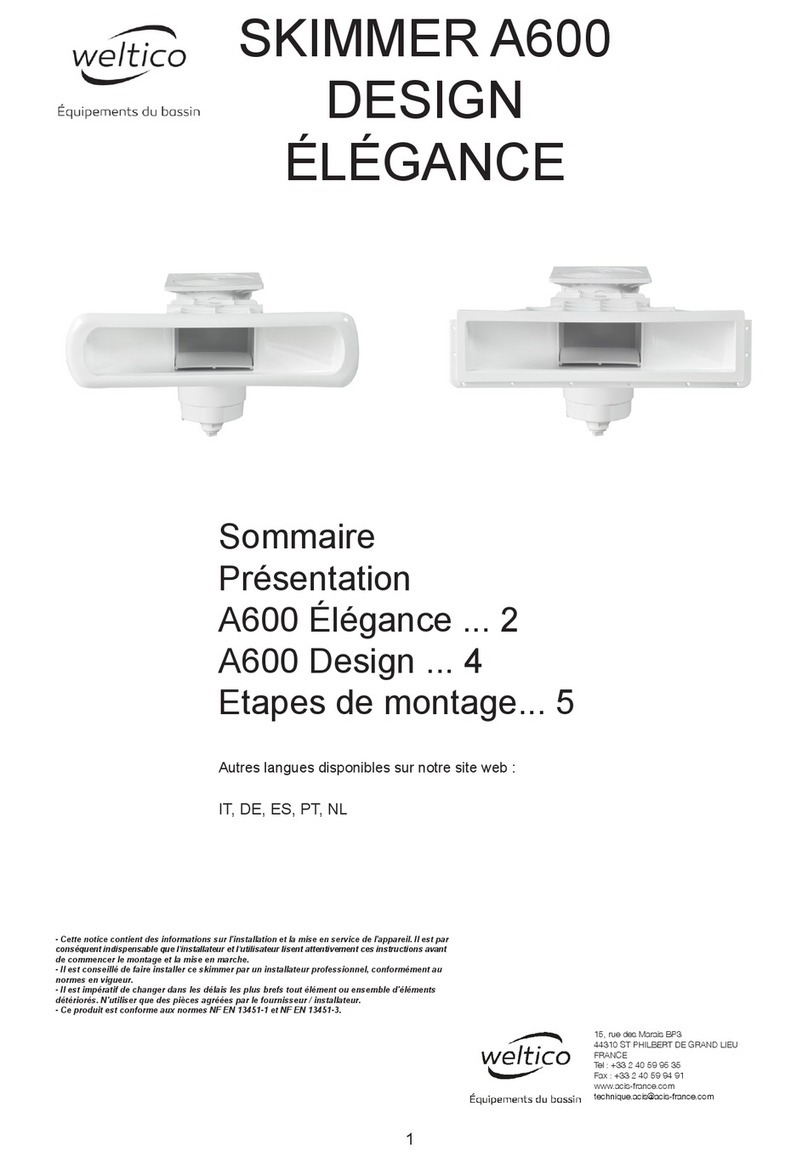
ACIS
ACIS weltico A600 ELEGANCE Assembly instructions

Pentair
Pentair FNS Plus FNSP 24 owner's manual
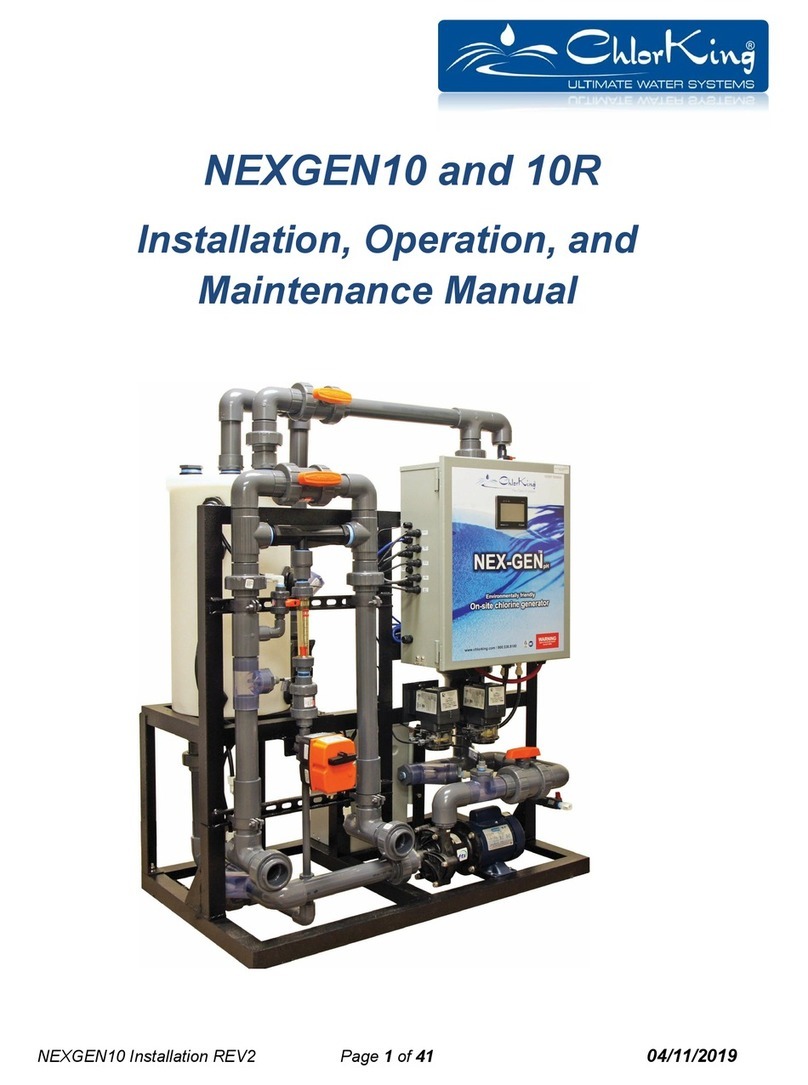
ChlorKing
ChlorKing NEXGEN10 Installation, operation and maintenance manual
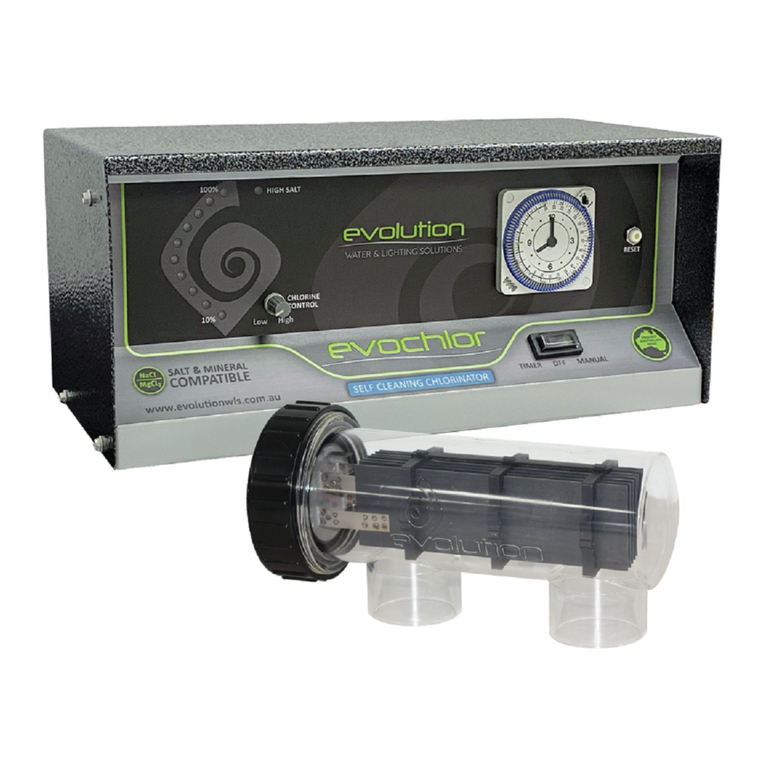
Evolution
Evolution A15TS Installation and operation manual
